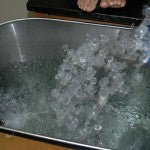FREE SHIPPING ON ORDERS OVER $25*
FREE SHIPPING ON ORDERS OVER $25*

If you are a runner, there is a very good chance that you have experienced shin pain. The number one cause of shin pain in runners is shin splints. Athletes who are in the early stages of shin splints usually experience pain when their runs first begin, but then the pain tends to disappear as their run continues.
It is common for their shin pain to return after exercise or the following morning. If the condition remains untreated and worsens, the athlete will find that they experience shin pain more often than not.
The term shin splints refers to pain along the large bone on the front of your leg, called your shinbone or tibia. The pain results from an overload on the shinbone and the connective tissue that attaches your muscles to the bone. People with shin splints often complain of mild swelling, soreness, or pain along the inner part of their lower leg or at their shin bone.
Icing can help the pain

Ice Dipping– Fill up your tub half full with water, add frozen water bottles or a bag of ice to get the water ICE COLD. Submerge your lower leg into the ice water all the way to your knees. Hold it in there for 10 seconds, walk around, and wait at least 5 minutes and then repeat the process 3-5 times.

Ice Massage – Fill small paper cups with water and freeze. Use one of the paper cups to massage the exposed ice into the most painful areas of your shins for a minimum of 5 minutes. Make sure you do not let the ice sit on one spot for too long.
For more information on shin splint pain solutions or to purchase shin splint treatments visit medi-dyne.com.
The post Shin Splints in Runners appeared first on Medi-Dyne.


